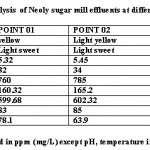Analysis and Physico-Chemical Parameters of Sarvar Devla Sugar Mill Studies of Effluents
Janeshwar Yadav1 * and R. K. Pathak2
1
Jawaharlal Institute of Technology,
Borawan,
Khargone,
451 228
India
2
New G.D. College,
Moti Tabela,
Indore,
India
DOI: http://dx.doi.org/10.12944/CWE.7.2.20
Copy the following to cite this article:
Yadav J, Pathak R.K. Analysis and Physico-Chemical Parameters of Sarvar Devla Sugar Mill Studies of Effluents. Curr World Environ 2012;7(2):313-315 DOI:http://dx.doi.org/10.12944/CWE.7.2.20
Copy the following to cite this URL:
Yadav J, Pathak R.K. Analysis and Physico-Chemical Parameters of Sarvar Devla Sugar Mill Studies of Effluents. Curr World Environ 2012;7(2):313-315. Available from: http://www.cwejournal.org/?p=2923
Download article (pdf)
Citation Manager
Publish History
Select type of program for download
| Endnote EndNote format (Mac & Win) | |
| Reference Manager Ris format (Win only) | |
| Procite Ris format (Win only) | |
| Medlars Format | |
| RefWorks Format RefWorks format (Mac & Win) | |
| BibTex Format BibTex format (Mac & Win) |
Article Publishing History
| Received: | 2012-07-12 |
|---|---|
| Accepted: | 2012-09-17 |
The recent studies have indicated that the water bodies becoming increasingly Contaminated due to the domestic and industrial wastes. The effluent discharge from sugar Mill consists of a number of chemical pollutants that can bring about changes in temperature, Humidity and oxygen supplies amounting to a partial or complete alteration in the physical, chemical and physiological sphere of the biota. Such changes disrupt the ecological cycle of Living organisms. Further, the letting of effluents sugar mill run into the natural water is responsible for bad quality water which affects aquatic life severely. It is, therefore, very essential to study the physico-chemical parameters and heavy metal contents of the effluents to ensure their proper treatment prior to their disposal into open land or natural water Resources. The present paper deals with the estimation of physicochemical parameters of sugar mill effluents collected from Neoly Sugar Mill, district Khargone M.P (India). This study was conducted during the december to January month2012, when sugar mill remained in its full crushing capacity.
Material and Methods
Samples of sugar mill effluents were collected from the different points on the drain viz. point-1 (the exit in the premises) point-2 (1/2 km. from point-1) and point-3 (1/2 km. from point-2) in the month of February 2012. The physico-chemical analysis of sugar mill effluents was carried out as per the standard methods for analysis of water, waste water and industrial effluents. All the testing were done at our institute laboratory. Where alkalinity. Hardness, chloride content determined by standard titration methods.
Result and Discussion
Physico-Chemical Parameters
The results related to the physico-chemical parameters of the sugar mill effluents collected at different time intervals from the various sites have been listed in the given table 1.
Colour
The colour of the effluent was found variable at different points. The effluents are yellow in colour and intensity decrease from Point-1 to Point-3.
Odour
The odour of effluents of the mill was found sweet to alcoholic from Point-1 to Point-3.
Temperature
The temperature is the highest at Point-3 and decreases appreciably up to Point -1.
pH
The pH value of the effluent sample varies from 5.32 to 5.89. pH values are increased with increase in the distance travelled by the effluent. The ISI permits a range of pH from 5.5 to 9 for the effluents that could be released into any natural water source (ISI 1974).
TH (Total hardness)
The term ‘Total hardness’ indicates the concentration of Ca2+ and Mg2+ ions only. It is expressed in terms of calcium carbonate. Total hardness varied from 760 to 800 mg/L.
Calcium (Ca2+)
Calcium values range from 160.32 to 200.4 mg/L.
Magnesium (Mg2+)
Magnesium values range from 599.68 to 625.5 mg/L, which are higher than the ISI limits.
Alkalinity
Alkalinity found at varying distance during winter season is of the order 83 to 90 mg/L. It is evident that the alkalinity at all the sampling sites was much greater than the recommended value, 50 mg/L.
 |
Table 1: Physico-chemical analysis of Neoly sugar mill effluents at different time intervals Click here to View table |
Chloride (Cl–)
The concentration values of chloride in the effluent samples ranged over 63.9 to 78.1 mg/L. It is explicit from the data that the pH of the effluents increases. The values for alkalinity and the concentration of the magnesium as well as ions are higher than the recommended value for the industrials effluents. The present study exhibits that the treatment of the effluent is being done regularly before its disposal into the natural water sourse. However, the maintenance of the treatment plant as well as the periodic training of the workforce are required.
Acknowledgement
The Authors are thankful to the Principal, Jawaharlal Instituite of Technology Borawan for providing thenecessary facilities.
References
- C. Manas, Ind. Chem Man, 14(3), 13-14 (1979).
- R. Deshbandu, et al. Ecology and Development, Vth (Eds), Indian Env. Soc., New Delhi, 178-190 (1979).
- S. R. Verma and G. R. Shukla, the Env. Health, 11, 145-162 (1969).
- B. K. Behra and B. N. Mishra, Ind. Res., 37, 390-398 (1985).
- S. Khurshid et al., Indian J. Environ, Health, 40(1), 45 (1998).
- N. Manivaskam, Physico-chemical Examination of Water Sewage and Industrial Effluents, IIIrd (Eds), Pragati Prakashan Meerut (1996).
- ISI, Tolerance Limits for Industrial Effluents discharged into Inland Surface Water IS, 2490, New Delhi (1974).
- BIS, Specifications for Drinking Water, IS, 10500, Bureau of Indian Standards, New Delhi (1991).
- P. R. Pratt, Quality Criteria for Trace Elements in Irrigation Waters, University of California Experiment Station, Riverside, California (1972).






